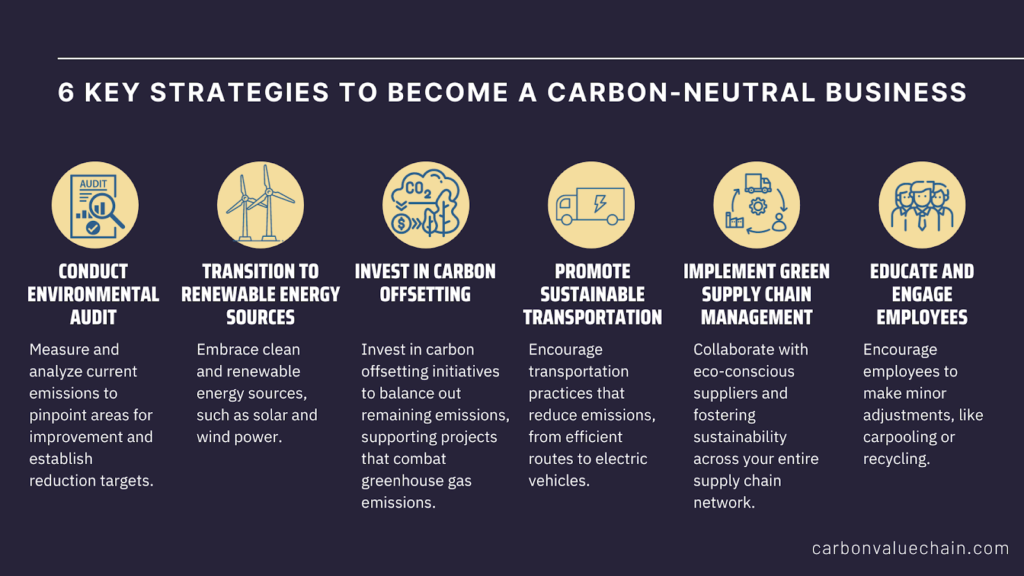How to Become a Carbon-Neutral Business: 6 Key Strategies
In an era where environmental sustainability is no longer a choice but a necessity, businesses are increasingly seeking ways to reduce their carbon footprint. As the demand for eco-conscious products and services continues to grow, becoming a carbon-neutral entity is not only an ethical imperative but also a strategic advantage.
But what exactly does it mean to be a ‘carbon-neutral business,’ and how can businesses align their actions to achieve this status? In this article, we will define carbon neutrality and outline six key strategies that businesses can implement to move toward carbon neutrality, all while maintaining their bottom line.
Background information: Carbon Neutral vs. Net Zero: What Is the Difference?
What Is a Carbon-Neutral Business?
A carbon-neutral business is one that effectively balances the amount of produced carbon dioxide with the amount it removes or offsets from the atmosphere. In practical terms, this means that the company does not contribute to the increasing amounts of greenhouse gases responsible for global warming and climate change.
To achieve carbon neutrality, there is a roadmap most businesses must follow.
- First, a business must measure its total climate impact by calculating the amount of greenhouse gases it produces.
- Following this, it must take concrete actions to reduce these emissions as much as possible.
- Subsequently, it can compensate for any remaining emissions by investing in environmental projects around the world that counterbalance the impact of their greenhouse gas emissions, often known as carbon offsets.
Remember, becoming a carbon-neutral business is not simply about mitigating environmental impact, but transforming business operations to enhance sustainability while promoting economic growth and stability.
6 Key Strategies to Become a Carbon-Neutral Business
Businesses should employ a holistic approach to carbon neutrality; there is no one-way-fits-all approach. Here are a few strategies to undertake to get started.

1. Conduct an Environmental Audit
Prior to taking any actions, it is imperative to comprehensively assess your business’s environmental impact. An environmental audit serves as a vital tool for pinpointing potential areas of improvement and gathering valuable data to establish reduction targets. During this assessment, it’s advisable to measure aspects such as energy consumption, waste production, and transportation emissions. This data will empower your business to pinpoint areas where it can make the most substantial contributions to reducing carbon emissions.
2. Transition to Renewable Energy Sources
Among the most potent strategies for businesses to curtail their carbon footprint is the shift to clean, renewable energy sources. These encompass solar, wind, and hydropower. By either generating clean energy on-site or procuring it from a renewable energy provider, businesses can significantly lower their carbon emissions and play a pivotal role in fostering a cleaner and more sustainable future.
3. Invest in Carbon Offsetting
While prioritizing emission reduction is paramount, it may not always be feasible for businesses to achieve complete carbon neutrality through their own initiatives. In such scenarios, channeling investments into carbon offsetting programs can help neutralize any remaining emissions. These programs entail supporting initiatives that mitigate or remove greenhouse gas emissions from the atmosphere, such as reforestation or renewable energy projects.
Read more: Corporate Carbon Offsetting: Exploring How Companies Can Achieve Carbon Neutral Emissions
4. Promote Sustainable Transportation
To further reduce emissions and enhance sustainability, businesses can go the extra mile by optimizing shipping and other transportation processes. Implementing efficient routing strategies not only minimizes fuel consumption but also decreases greenhouse gas emissions associated with cargo transportation. Additionally, integrating electric vehicles into the company’s fleet can be a game-changer. Electric vehicles, with their lower carbon footprint and reduced operating costs, are one strategy many businesses are using today to become carbon neutral without forfeiting profits.
5. Implement Sustainable Supply Chain Management
A business’s carbon footprint extends beyond its own operations and encompasses the emissions generated by its supply chain. By collaborating with suppliers committed to sustainability and the reduction of their own carbon emissions, businesses can actively contribute to forging a more sustainable supply chain ecosystem.
6. Educate and Engage Employees
Enlightening employees about the significance of carbon neutrality and actively involving them in sustainable practices can wield a substantial impact on reducing a business’s carbon footprint. Encouraging employees to make minor adjustments in their daily routines, such as employing reusable containers or participating in carpooling, can cumulatively lead to noteworthy reductions in emissions.
For more actionable tips on reducing emissions, check out our guide: How to Reduce Scope 3 Emissions: What Scope 3 Emissions Are and How Companies Can Address Them
Your journey to becoming a carbon-neutral business doesn’t have to be comprised of major changes; Small changes in day-to-day operations can add up to significant reductions in carbon emissions. Encourage employees to recycle, implement energy-saving practices such as turning off lights and electronics when not in use, and choose sustainable suppliers for office materials. These simple, sustainable practices can have a significant impact on reducing your business’s carbon footprint.
